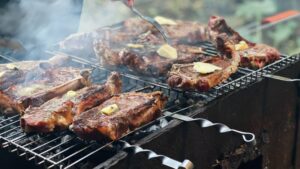
How To Enhance Your DIY Meat Probe with Voice Control Features
Every culinary enthusiast knows the importance of a perfectly cooked steak, and that’s where a meat probe comes in handy. But what if we could

To smoke a 10 lb. brisket, it usually takes about 10-12 hours at 225 degrees.
Everyone loves a good, juicy smoked brisket. We have smoked lots of briskets and learned from top Texas barbecue experts. We will give you great tips from famous pitmasters too.
The time it takes depends on how well you keep the smoker at 225 degrees. Remember, this time is just a guide. Unlike baking, you don’t take the brisket out just because a set time has passed.
You should take out the brisket when its inside temperature is between 190-203 degrees, especially in the thickest part.
We usually remove it at 197 degrees following our full method. Other expert cooks might choose anywhere from 190-203 degrees, based on their way of cooking. Don’t worry too much about the exact temperature to take it out. You’ll still get a great brisket if you do it within this range and let it rest properly afterward.
This matches the general rule for brisket: smoke it for 1- 1.25 hours per pound, keeping the temperature steady at 225 degrees.
Ready to try smoking your first beef brisket? Keep reading for our best advice.
Smoking a 10lb brisket is a big task because this meat is tough. You need to pay close attention to the details. Knowing small things about the meat, like its connective tissue, can really change how it turns out.
A 10-pound whole brisket can feed around 18 people. So, get ready for this exciting cooking challenge. Prepare in advance for every step you need to take.
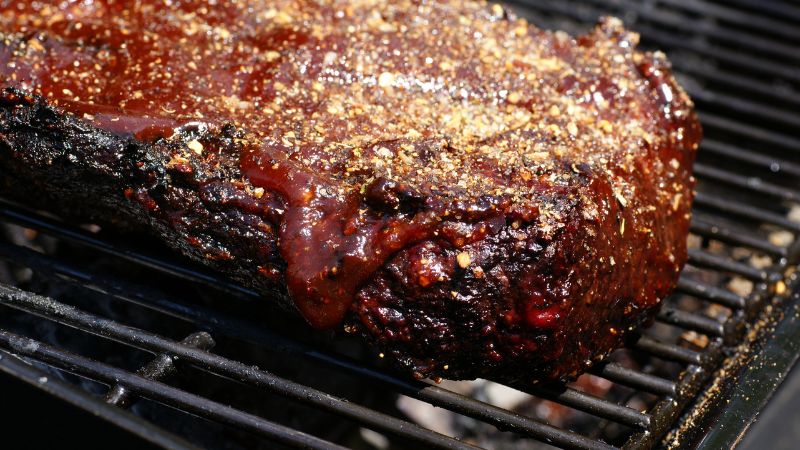
The first step is picking the right brisket. Look for a whole brisket in a vacuum-sealed package, often called a packer brisket. You’ll find these full packer briskets at grocery stores, Costco, Sam’s Club, and online. You can also get your brisket from a trusted butcher.
Imagine splitting the brisket in half in your mind. One side of the brisket, called the brisket flat, is leaner. This side looks thin and flat, different from the other side which is thicker and has more fat running through it, making it juicier.
For beginners, it’s better to cook the whole brisket, not just the flat part. If you only cook the flat, it can easily dry out if not done right. It’s best to avoid stores that sell only the flat. This way, you get the full experience of smoking a whole brisket. If you’re interested in cooking just the flat, we’ll have a guide for that soon.
Briskets come in 4 different grades.
The grades, from lowest to highest, are select, choice, prime, and wagyu.
These grades mainly depend on how much intramuscular fat the meat has.
A higher grade means more intramuscular fat in the brisket. This is important because the fat gives flavor and juiciness to the brisket. The juicier the brisket, the better it tastes. (There’s more detailed info about intramuscular and intermuscular fat in another post.)
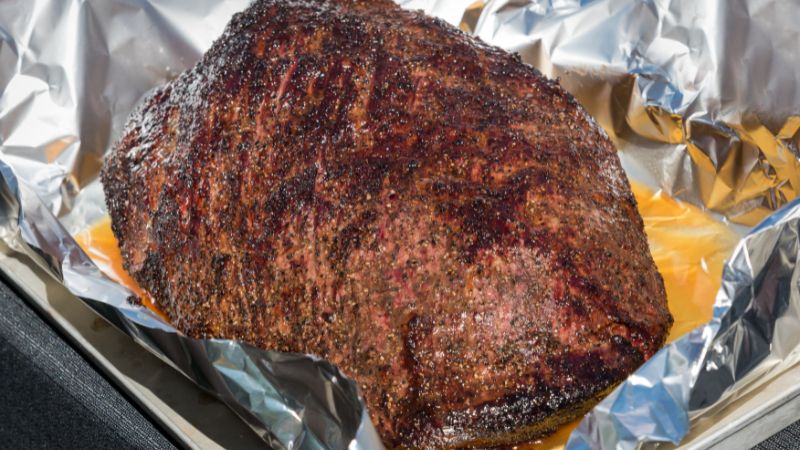
This is why smoking just the flat part can be tricky. If it’s not done well, the brisket might not be enjoyable, and you might not want to try again.
Intramuscular fat is also known as “marbling”. It looks like thin lines of fat running through the meat, similar to lines in marble stone. This fat is like magic for brisket. It melts during cooking, keeping the meat juicy from inside. Higher-grade meats have more marbling, so they tend to be pricier.
Once you bring your brisket home, the first step is to get it ready for smoking. Start by chilling the brisket, which makes the fat firmer and easier to trim. This is a useful tip not everyone knows about. It’s much simpler to work with a large, cold cut of meat because the fat won’t melt and make it slippery.
Put the brisket in the freezer for 30 to 45 minutes. When it’s chilled, take it out of its packaging and pat it dry with paper towels. Then, place it on a cutting board. To keep the board from sliding, put a wet paper towel underneath it. Now, use a large sharp knife to trim off the extra fat and shape the brisket. We have a post about choosing the best knives for barbecue if you need tips on that.
Having the right amount of fat is key for a delicious brisket, but too much fat on the outside won’t cook properly. It can make your smoker messy and leave big chunks of fat on your cooked brisket. So, the first step is to trim the fat. Here’s what you need before you start:
Put wet paper towels under your cutting board to keep it steady while trimming. A brisket at room temperature can slip around, making it hard to trim. You can also place paper towels under the brisket if it starts to slide.
Use a really sharp knife (a good knife sharpener can help here) to trim away extra fat until it’s about 1/4-1/8 inch thick. Thicker fat won’t melt away during smoking. Wearing gloves, try to keep one hand dry and used for non-meat tasks, and the other for handling and adjusting the meat.
Trimming Each Part of the Brisket, let’s look at how to trim each part of the brisket.
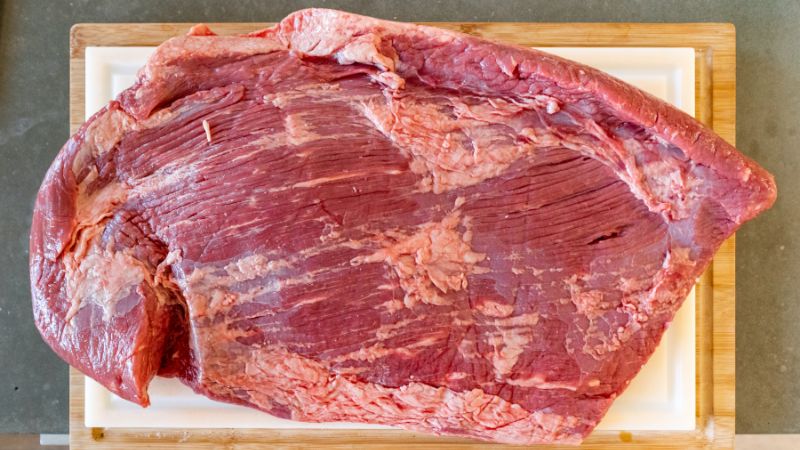
The fat cap side is the white side covered in fat. You might not need to trim this side much. If you do trim, leave about ¼ inch of fat. This is especially important if you’re using a pellet smoker, as you should smoke your brisket with the fat side down. For more on smoking a brisket in a pellet smoker, check out this post.
On the meaty side of the brisket, remove the thin layer of skin (it looks cloudy) and any hard fat (it feels rough). By doing this, you expose more of the meat’s surface to the smoke. Trimming off fat on this side helps develop the bark, which adds great flavor and a nice crust to your brisket.
Adding a rub to your brisket is a great way to boost its flavor. You can find many rub options on Amazon, at BBQ specialty stores, or in cookbooks by your favorite pitmasters. Here’s our own award-winning brisket rub recipe, perfected over 12 years.
The rub you choose depends on your taste preference or the flavor you want to achieve. It can be a mix of different ingredients.
Here are some beef rub examples:
Remember, there’s no single correct way to rub a brisket. Try different rubs each time you smoke and see which ones your family enjoys the most.
To apply the rub to your brisket, simply shake it onto the meaty side and the sides of the brisket. You can also sprinkle a little on the fat side. It’s important not to rub the seasoning into the meat, which is a common mistake.
Just sprinkle the rub on, let it sink in, and then add a bit more before putting the brisket in the smoker. If you’re doing this for the first time, you might want to watch our videos to get a sense of how much to use.
Generally, using about 1/3 to 1/2 cup of rub, depending on which one you’re using, is enough.

When smoking a brisket, one big question is the best temperature for your smoker. Smoking your brisket at around 225 degrees is ideal. This low temperature allows the beef to cook slowly, breaking down the connective tissue properly.
The perfect temperature for your brisket can depend on the type of smoker you have. Some famous barbecue experts say they cook brisket hot and fast. However, their expensive, custom-built smokers have features like multiple water pans, rotating racks, and air circulation motors that aren’t typically available to most people.
For backyard BBQ enthusiasts, smoking your brisket at higher temperatures like 275-325 degrees can result in a dry brisket. This is because the meat doesn’t get enough time to break down the connective tissue and collagen, which makes the brisket tender. So, get ready for a slow-smoked, but reliably juicy brisket.
Remember, this won’t be a quick process, but you can grill some snacks like sausage links, chicken wings, or breakfast sausage on the barbecue. These will be ready in just a few hours while you wait!
Put a water pan in the smoker on the opposite side of the rack from the brisket. This creates humidity in the chamber. The best way to do this is to place the pan in the smoker and then fill it with water from a pitcher.
Before sealing your barbecue smoker, you should insert a probe thermometer into the thickest part of your brisket. We highly recommend The Meater, a popular thermometer in the barbecue world. It’s great because it sends notifications from the probe to an app on your smartphone, so you can easily check the meat’s temperature.
If you’re using a pellet smoker, use the meat thermometer that connects to the grill to monitor the brisket’s internal temperature. With the brisket fat side down, place the thermometer in the thickest part of the meat. If your smoker doesn’t have a built-in thermometer, it’s a good idea to get one. We often recommend the Meater or the ThermoPro in our posts, as they are both durable and reliable. When smoking, position the brisket as far from the heat source for your pellets as possible.
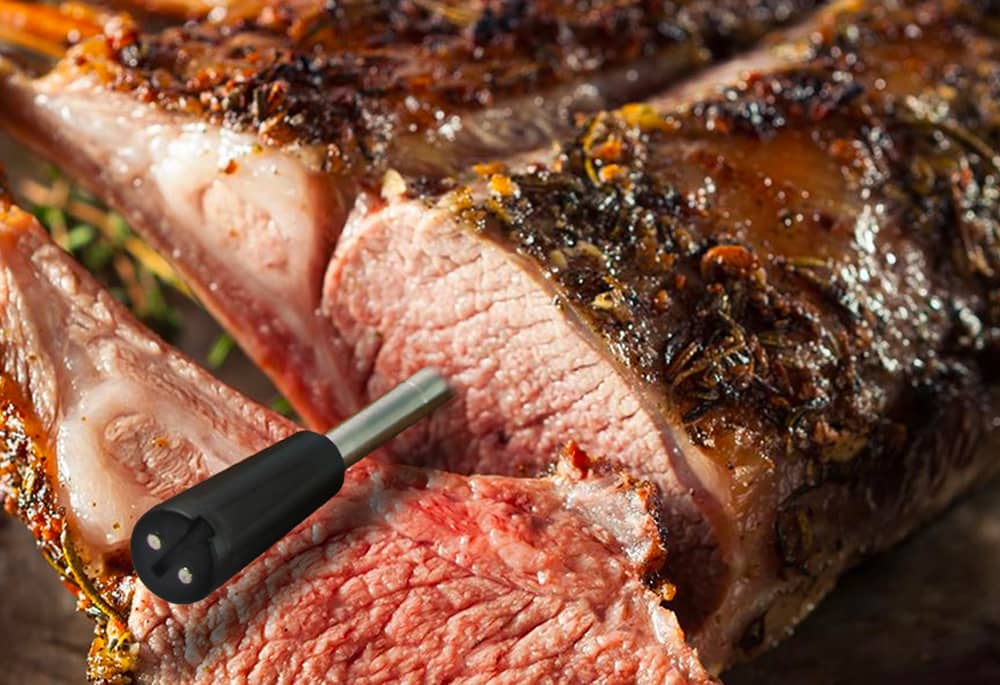
Once your brisket has been smoking for 3-4 hours, the bark should be well set, and you can start spritzing the brisket. This is when you can use a good brisket spray recipe.
To make your own brisket spray, mix ingredients like apple juice, beef broth, apple cider vinegar, or water. Spraying the brisket while it cooks helps to keep the meat moist and enhances the smoke flavor.
When the internal temperature of your brisket reaches 170 degrees, it’s time to take it off the smoker and wrap it. This helps the brisket get through a period known as “the stall.” During the stall, condensation from the brisket’s cool interior forms on the surface, cooling it down and preventing the temperature from rising.
Many beginners panic when they see this, but it’s a normal part of the smoking process. To avoid waiting, you can wrap the brisket in pink butcher paper, which helps prevent cooling.
You have the option to wait out the stall and leave the brisket unwrapped, which will eventually lead to rising temperatures, or you can wrap it to speed up the cooking process.
You don’t have to wrap your brisket, and you don’t have to do it precisely at 170 degrees. You might choose to wait until the temperature is a bit higher, but we’ve found that wrapping at 170 degrees, compared to wrapping at a higher temperature or not wrapping at all, results in the best and quickest brisket. Experiment with different methods to find what works best for you.
While some people use aluminum foil, we’ve found that butcher paper is the best option because it allows for airflow and is porous, aiding smoke circulation. Wrap your brisket in two layers of butcher paper, then place it back in the smoker until the temperature reaches 190-203 degrees.
A 10 pound brisket typically cooks for 10-12 hours at 225 degrees. As a general guideline, you should aim for 1- 1.25 hours of cooking time per pound. However, your specific cooking time will depend on how well you maintain a consistent temperature of 225 degrees in your smoker.
The last, and very crucial, step is to let your wrapped brisket rest. This might seem optional, but for the best flavor and tenderness, resting is key. Professional chefs and barbecue competition winners always include this step. During the rest, any remaining connective tissue breaks down into juice, resulting in perfect, tender slices of brisket.
After smoking, take the brisket out and wrap it in a beach towel. Then, place it in a standard cooler. If you don’t have a cooler, you can put it on a baking sheet and leave it in your oven, which should be turned off.
We recommend letting the brisket rest for 1-4 hours before slicing it. This rest period is essential for achieving the optimal taste and texture.


Every culinary enthusiast knows the importance of a perfectly cooked steak, and that’s where a meat probe comes in handy. But what if we could

When it comes to cooking perfection, a meat probe is an indispensable tool for any chef or home cook. But in the world of meat
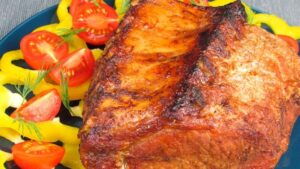
The moment you bring a meat probe into your kitchen, it’s not just about cooking anymore; it’s about precision, about transforming an ordinary meal into

Ever questioned if a meat probe could be your secret weapon for the perfect roast chicken? It’s a culinary showdown: the precision of a meat
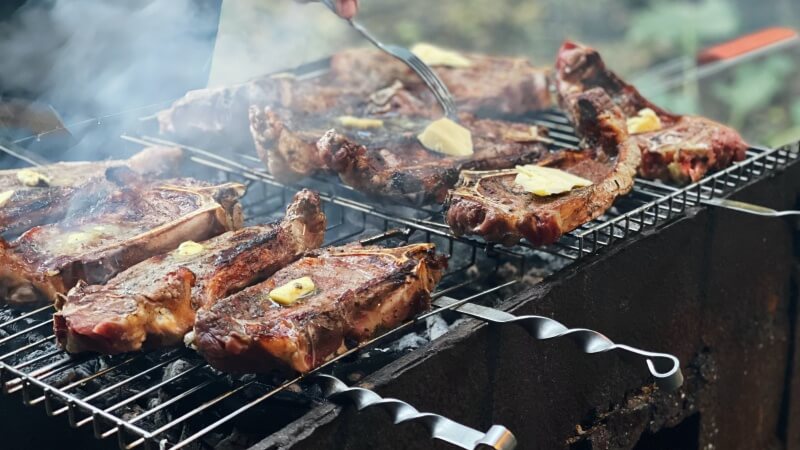
Every culinary enthusiast knows the importance of a perfectly cooked steak, and that’s where a meat probe comes in handy. But what if we could

When it comes to cooking perfection, a meat probe is an indispensable tool for any chef or home cook. But in the world of meat
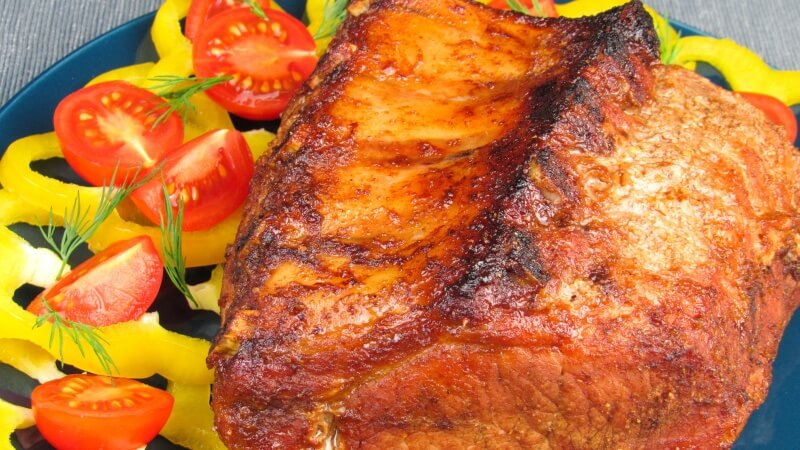
The moment you bring a meat probe into your kitchen, it’s not just about cooking anymore; it’s about precision, about transforming an ordinary meal into

Ever questioned if a meat probe could be your secret weapon for the perfect roast chicken? It’s a culinary showdown: the precision of a meat
Copyright © 2024 meaterprobe. All Rights Reserved.